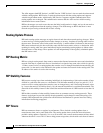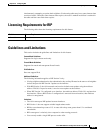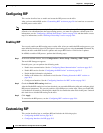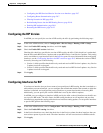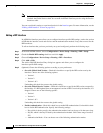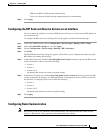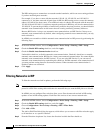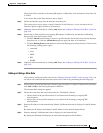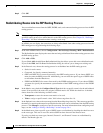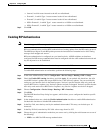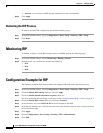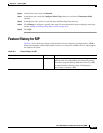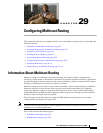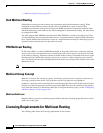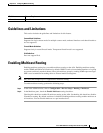
28-10
Cisco ASA 5500 Series Configuration Guide using ASDM
Chapter 28 Configuring RIP
Customizing RIP
Step 5 Click OK.
Redistributing Routes into the RIP Routing Process
You can redistribute routes from the OSPF, EIGRP, static, and connected routing processes into the RIP
routing process.
Note Before you begin this procedure, you must create a route map to further define which routes from the
specified routing protocol are redistributed in to the RIP routing process. See Chapter 26, “Defining a
Route Map,” for more information about creating a route map.
In ASDM, you can display the routes that are being redistributed from other routing processes into the
RIP routing process by performing the following steps:
Step 1 In the main ASDM window, choose Configuration > Device Setup > Routing > RIP > Redistribution.
The Redistribution pane displays the routes that are being redistributed from other routing processes into
the RIP routing process.
Step 2 Click Add or Edit.
If you clicked Add, the Add Route Redistribution dialog box allows you to add a new redistribution rule.
If you clicked Edit, the Edit Route Redistribution dialog box allows you to change an existing rule.
Step 3 In the Protocol area, choose the routing protocol to redistribute into the RIP routing process:
• Static, for static routes.
• Connected, for directly connected networks.
• OSPF and OSPF ID, for routes discovered by the OSPF routing process. If you choose OSPF, you
must also enter the OSPF process ID. Additionally, you can select the specific types of OSPF routes
to redistribute from the Match area.
• EIGRP and EIGRP ID, for routes discovered by the EIGRP routing process. If you choose EIGRP,
you must also specify the autonomous system number of the EIGRP routing process in the EIGRP
ID field.
Step 4 In the Metrics area, check the Configure Metric Type check box to specify a metric for the redistributed
routes. If not specified, the routes are assigned a default metric of 0. When the check box is checked,
choose from one of the following available values:
• Transparent to cause the current route metric to be used.
• Value to assign a specific metric value. Valid values range from 0 to 16.
Step 5 In the Optional area, choose the route map from the Route Map drop-down list. This route map specifies
the name of a route map that must be specified before the route can be redistributed into the RIP routing
process. Click Manage to configure a specific route map. For more information about configuring route
maps, see the “Adding or Editing a Route Map” section on page 26-4.
Step 6 In the Match area, choose specific types of OSPF routes to redistribute by checking the check box next
to the route type. This area is not active unless OSPF has been chosen in the Protocol area.
If you do not check any route types, Internal, External 1, and External 2 routes are redistributed by
default. The Match types are:



